Menu
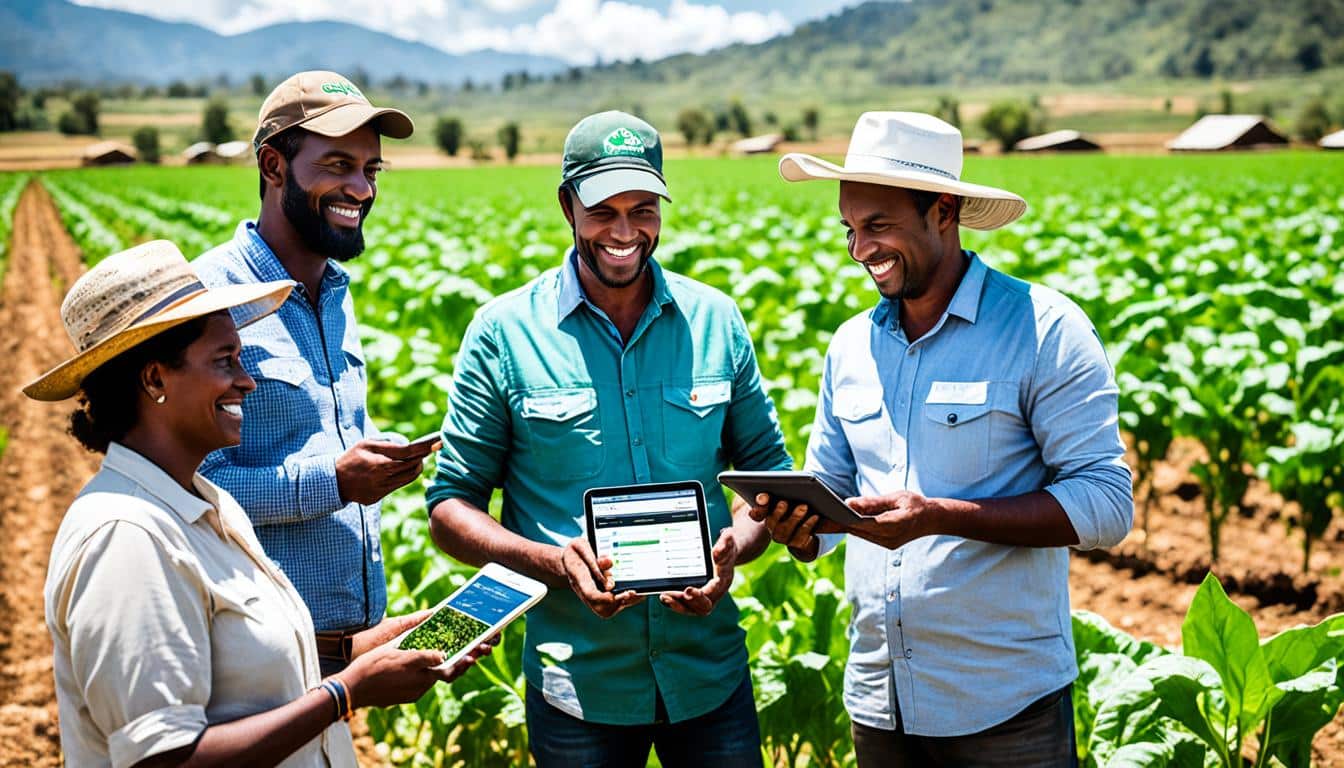
Did you know, small farmers in Africa make 80% of its food? This shows how important digital tools are for farmers. Through technology, the way farming works is changing all over the world. Online platforms help farmers connect with buyers. They also solve problems like how to get to markets, not having enough money, and lacking good roads.
Digital tools change how farmers and others do business, from selling to buying. They’re not just for trading but also help with big issues like fairness for women and fighting climate change. The future of farming depends a lot on these tools.
Now, digital agricultural platforms play a crucial role in connecting stakeholders. They’re key in supporting collaborative farming technology. This technology breaks down old barriers for small-scale farmers.
Digital agricultural platforms are like online marketplaces for agriculture. They let farmers and other players in the field connect, trade, and share. Thanks to digital solutions for agriculture collaboration, these platforms make farming more inclusive and efficient.
Digital platforms are vital in agriculture today. They bring many benefits through advanced technologies:
In Kenya, the use of digital farming services is ahead. But, not many farmers in Kenya or Africa use these tools. The main obstacles are a lack of tech devices and digital skills. To fix this, efforts are needed to increase internet and power in rural places, make devices cheaper, and help farmers and tech experts work together more. This way, more farmers can benefit.
Started in 1996, the Agricultural Technical Cooperation Working Group focuses on boosting farming skills and using digital tools. It brings together governments, schools, and businesses to improve farming practices and digital growth.
In the digital agriculture world, several key players help smaller farmers. Banks, mobile network operators, big agricultural businesses, and governments all play important roles. They work together to make farming easier and empower small farms.
Banks are crucial for farmers to get financial help. They offer services like loans, savings, and insurance. This support is key for farmers to do business safely. Banks also provide digital spaces for farmers to manage their money easily.
MNOs help by providing the phone systems that connect farms digitally. They make sure everyone involved can talk to each other instantly. These connections are vital for sharing information and getting products to market.
Big agricultural companies help small farmers by making strong links in the supply chain. They push for the use of new technology, making farming more productive and connecting with buyers easier.
Governments work to make a good environment for digital farming to grow. They create policies and rules that support using digital tools. This helps farmers do better and protect the environment.
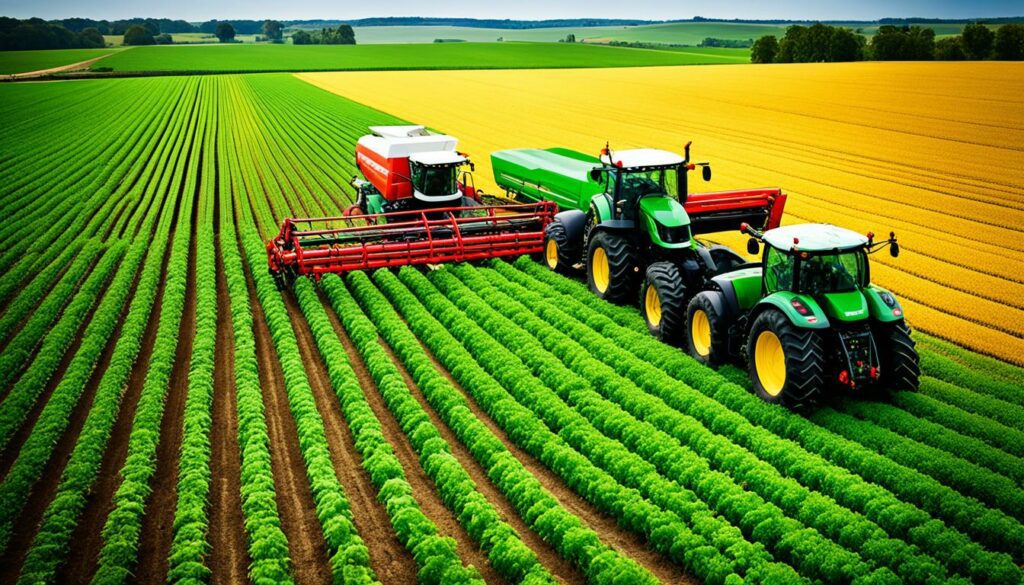
Together, banks, MNOs, big companies, and governments back small farmers. Mercy Corps AgriFin is a great example of this teamwork. It has worked with lots of groups to help tech improve farming.
The White Paper shows how important these groups are in Africa. They boost technology use in farming. Though there are challenges, their effort in tackling issues like helping new businesses grow, teaching new skills, and promoting fairness is vital.
The Mercy Corps AgriFin’s DAP Program lasts six months, created with GIZ and Dalberg. It aims to find long-lasting ways to grow digital farming in Kenya and Nigeria.
The DAP program’s aim was to make digital platforms bigger in important markets in Africa. It was supported by GIZ and Dalberg. They worked hard to help small farmers by connecting them online. This way, they made farming smarter and more productive. Their research showed how digital tools can change farming for the better.
The program found that digital platforms are key to fighting climate change and making things equal for men and women. It highlighted the big challenges tech experts face, like getting new customers cheaply and finding money. The program also said sharing farmer data helps everyone, especially farmers and tech platforms.
| Insight | Details |
|---|---|
| Increase in Farmer Productivity | Data-driven tools and real-time market access significantly boosted farmers’ output. |
| Gender Equity | Emphasis on gender-inclusive practices improved participation and benefits for women farmers. |
| Climate Resilience | Technologies focused on sustainable farming practices aiding in climate adaptability. |
| Financial Sustainability | Insights into creating economically viable digital agriculture platforms. |
| Challenges for Tech Innovators | Need for reducing customer acquisition costs and increasing access to finance. |
Connecting farmers through digital platforms is a very powerful change. The DAP findings give a guide. They show how working together digitally can make farming better and safer in Kenya and Nigeria.
Digital platforms are a game-changer for smallholder farmers. They help improve their market standing. Madhavan is one of many, with 86% of India’s farming economy belonging to smallholders.
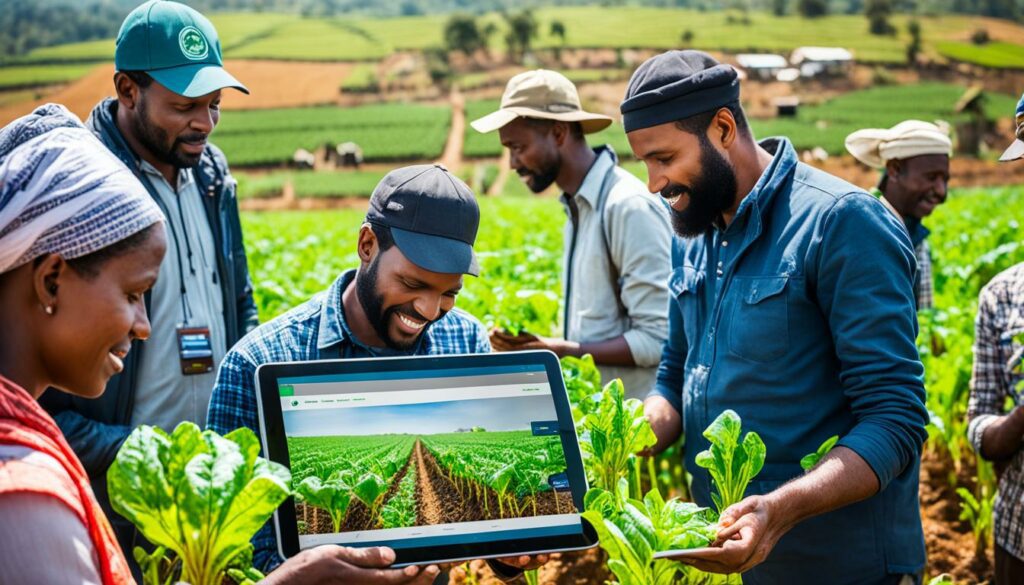
Thanks to digital solutions for agriculture, farmers connect with wider markets. They can now deal directly with buyers and sellers, avoiding middlemen. This leads to better sales, prices, and more business opportunities.
Digital platforms also provide essential financial services like credit and insurance. Over 65% of the world’s poor workers depend on agriculture. These services help to steady their incomes, lower risks, and encourage growth. Such digital tools support sustainable farming practices.
Training and skills are key in agriculture, with a significant global workforce. Digital solutions offer educational content and insights. They help farmers learn advanced techniques. This ongoing learning boosts their productivity and competitiveness.
They are vital as we work towards a more sustainable and resilient future. Groups like the World Economic Forum and the EDISON Alliance are pushing for this change. By supporting smallholders in digital adoption, we can tackle food scarcity and ensure a strong agricultural economy worldwide.
Digital platforms are bringing about a new era in farming, helping to make agriculture more sustainable and resilient. But, tech innovators face many challenges when trying to grow their digital solutions. The main issues include the high costs of finding customers, not having strong networks, and barriers to getting funds and investments.
A big challenge is how much it costs to get customers on board. Bringing small farms and businesses into the digital world takes a lot of work and education, especially in rural areas. Tech companies find it hard to spread the word and teach people because it’s costly. This makes it tough for them to grow.
A key problem is not having strong networks. It’s really important to work with others, like government officials and financial groups, to get digital tools working in agriculture. Without these connections, getting into the market and earning trust is very difficult.
Getting enough money and investments is also a major issue. Even though using digital tools can boost production and make farming more eco-friendly, getting money is tough. People see it as risky and it takes a long time to see the profits. This means it’s hard for tech entrepreneurs, especially in less developed areas, to find investors for their agricultural projects.
To make digital farming more widespread, we need to tackle these issues. Coming together to create strong networks, with focused money and new ways to fund, can help break down these problems. This will let more agricultural businesses take up digital technology.
Climate-smart agriculture uses both new tech and green practices. It helps farms survive severe weather and stay green. The online agricultural network and farm digitization partnerships are key to this.
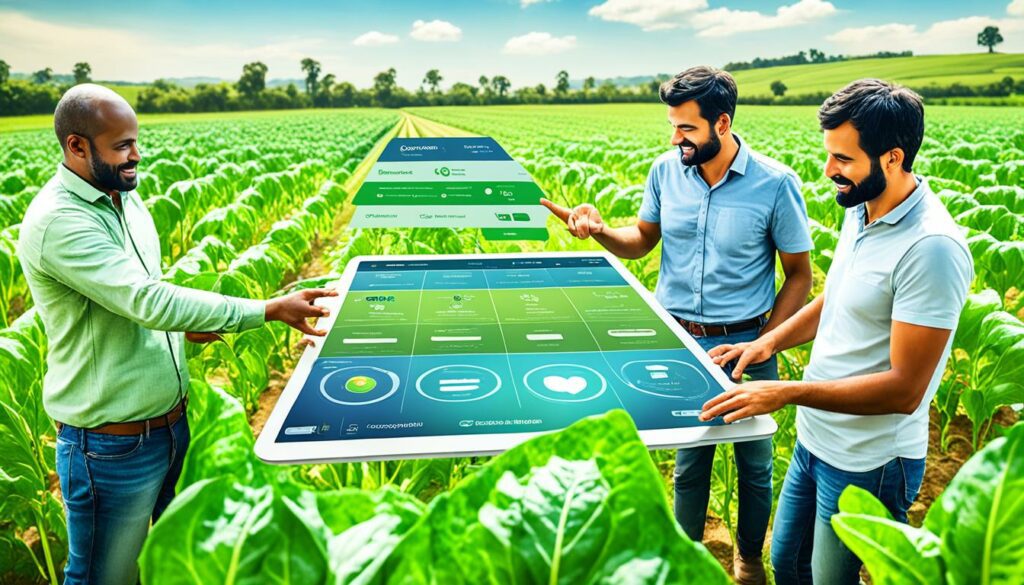
New tech is boosting climate-smart farming wonderfully. For example, Kheyti’s small greenhouse makes farmers more productive yet conserves water. This tech raises their income greatly, thanks to farm digitization.
Then there’s VIA’s Virtual Irrigation Academy, known for its easy, cheap tools for better water and fertiliser use. This tech helps lots of farmers and irrigation experts work smarter, showing the online agricultural network‘s benefits.
Money support is crucial in green farming. Take the Farmers for Soil Health project, aiming to plant cover crops on large lands across 20 states. With $95 million funding, it boosts green farming and smart tech use.
| Project | Scope | Funding Ceiling |
|---|---|---|
| Farmers for Soil Health | 1 million acres of cover crops in 20 states | $95,000,000 |
| Midwest Climate-Smart Commodity Program | 20% of contracts reserved for underserved populations | $95,000,000 |
| Strengthening Grassroots Leadership | Improve grassroots leadership capacity | $90,000,000 |
| Climate SMART | 43 states, 11 underserved producer organizations | $90,000,000 |
Digital platforms, especially farm digitization partnerships, help farms get ready for climate change. They gather resources and support smart financial tools. This team effort is crucial for farming future-proof and helping small farmers worldwide.
Bringing gender fairness into digital farming helps more than one goal. It boosts farm work and helps rural women grow their lives. Many digital tools use teamwork and the power of rural women to improve farming for all.
In Africa’s south of the Sahara, women are half the farming force. But, they make up only 25% of those using farming technologies. This gap shows we need digital ways that fit women’s farming needs. For example, Climate Smart Coffee by Sprout helps more women grow coffee. They give tips via SMS and tailored help.
Getting separate data for women is stalling, with 43% of platforms finding it tough. Most platforms can at least tell how many men and women use their services. But not many, like CoAmana, use this to attract more women. The key is to actively include women in farming tech. Setting goals and tracking progress is crucial.
Just including rural women isn’t enough. They need direct help with money, farming know-how, and ways to sell their produce. Many women in the countryside don’t own phones, blocking them from vital digital tools. Joint tech efforts, like those from Bee-Kind and Farm2Go, help close this tech divide. They bring women together and offer them support and tips.
Backing from donors and investors is key to breaking into farm markets and supporting rural women. When digital tools for farming put women first, everyone benefits. It makes farming more lasting and fair.
Digital platforms are key in sharing knowledge in farming. They help different people in farming work together. This makes it easy to spread important facts and top ways of working.
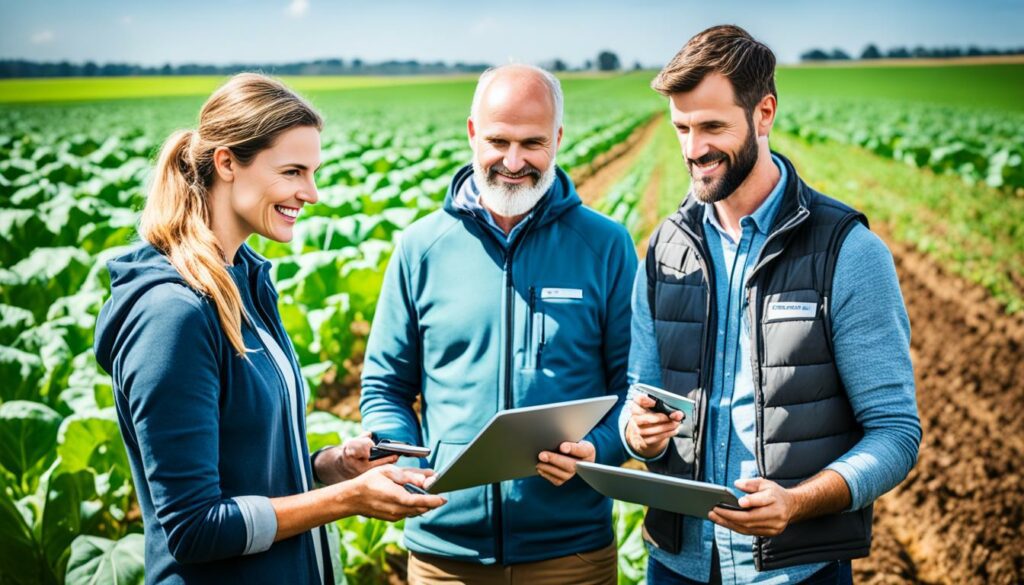
These platforms are crucial for building teamwork and networks in farming. They connect everyone from farmers to scientists online. By doing so, people can share ideas, ways to do things, and new discoveries. This is really important for the planet’s health.
One big advantage of these platforms is easy access to farming info. They give small farmers lots of help on how to grow crops better, keep the soil healthy, and fight off bugs. Having this info helps farmers do better and choose what’s good for the Earth.
Also, connecting farmers online means everyone can get the newest info and tools, even if they’re far away. This helps to look after the planet while keeping farms going strong.
The world of farming is changing with digital transformation. New trends in technology and data insights are emerging. These are set to change the way we farm by using advanced tools.
Predictive analytics is key in smart farming. It looks at lots of data to forecast things like crop yields, soil health, and pests. Experts say that farm data will grow over 800% by 2036. This huge data will help farmers make better choices, lower risks, and boost productivity.
AI is set to make big changes in farming. It helps with rapid insights and automation. For example, real-time field data from cloud tools cut trial costs and time. Also, artificial data makes it quicker to introduce new farm products.
AI and machine learning push advancements in food production too. They improve sustainability by imitating nature. Digital for Agriculture (D4ag) has over 1,400 solutions, promising better productivity and reduced costs for farmers everywhere.
Future trends highlight a big shift for agriculture, with AI and analytics leading the change. These innovations make farming more efficient and sustainable. They lay the foundation for a farming future that’s better for everyone.
Digital platforms are changing farming by creating an online agricultural network. This network brings together farmers, technologists, and leaders. They share knowledge and resources, boosting collaboration.
The use of digital platforms is growing more in the US and the EU. Farmers there exchange best practices, like dealing with pests. These tools help with common challenges farmers face, such as market changes and support during crises.
There is a big push to help farmers deal with crisis impacts and to update their businesses. This also helps young and new farmers. But there is a problem of not everyone being able to access digital tools, such as in Africa.
Collaborative farming technology is making big changes in the industry. Digital Green has helped over 5.6 million farmers, mostly women. It has lowered the cost of new farming methods from $35 to $3.50. This shows making technology cheaper and available is possible.
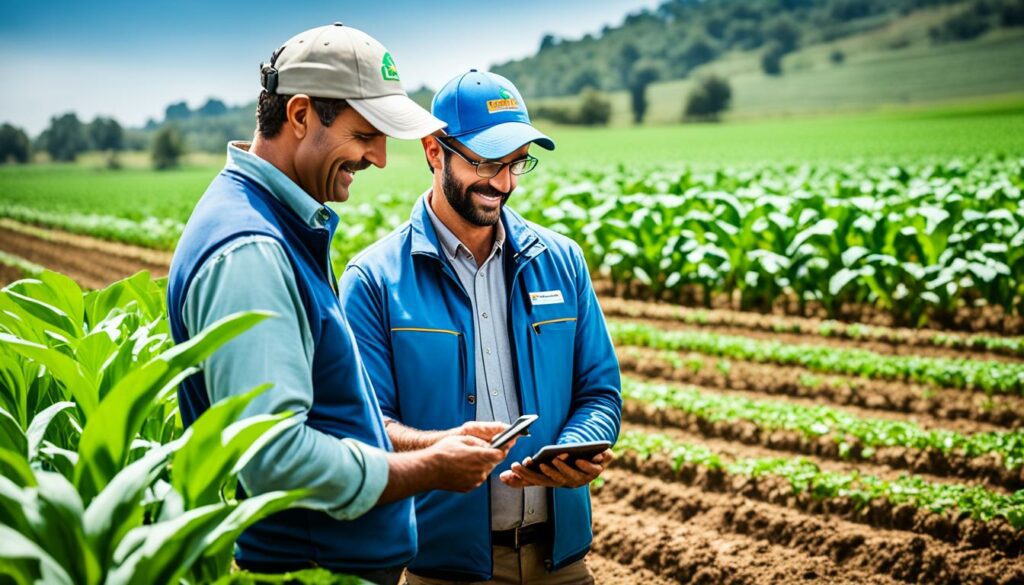
In the Mashreq countries (Iraq, Jordan, and Lebanon), digital tools are helping farmers export high-quality products. This means they can reach better markets. These tools focus on using data for planning, predicting, and helping farmers sell better.
| Region | Initiatives | Impact |
|---|---|---|
| United States & Europe | Best Practice Exchange | Improved pest management and market stability. |
| Africa | Scaling Disruptive Technologies | Identification of 194 scalable innovations. |
| Mashreq Countries | High-Value Product Exports | Increased market access and revenues. |
| Global | Digital Financial Services for Agriculture | Enhanced financial sustainability and services. |
Adding digital solutions to the food supply chain boosts efficiency and sustainability. It helps agriculture be more open and productive.
Donors and investors are key in advancing digital AgTech. They help by providing funds for new ideas, technical help, and measuring results. Their work boosts the use and success of digital tools in farming.
Investments in digital AgTech bring big changes to farming. Help from donors and investors makes new tools possible, which makes farming better for smallholders. Interestingly, women in sub-Saharan Africa are less likely to use these tools. Targeted funds can help more women use AgTech.
Helping farmers learn about digital solutions is very important. Training like how to use tools can speed up how fast farmers adapt. But, it’s found that making sense of data about how different groups use these tools is hard. Making this data easier to understand can improve AgTech for all.
Knowing how well digital farming tools work is crucial. Many platforms are now making gender equality a top goal. Using data about who uses these tools helps make them better for everyone. Creating new ways to measure success can help reach big goals, like ending hunger.
“The opportunities are immense for digital platforms to use sex-disaggregated data to design better gender-equitable products and services,” says the report. Embracing these opportunities necessitates collaborative efforts from donors and investors alike.
| Role | Primary Functions |
|---|---|
| Donors | Funding innovations, providing technical assistance, offering investment capital |
| Investors | Evaluating impact and sustainability, incentivising data collection, promoting gender-forward actions |
| Platforms | Utilising sex-disaggregated data, enhancing market access, offering skill development |
Establishing sustainable agribusiness partnerships is key in updating the agricultural sector. With digital solutions, farmers and businesses can connect and share resources. This helps in their growth and sustainability. These platforms are vital for tech collaborations in agriculture, boosting both efficiency and green practices.
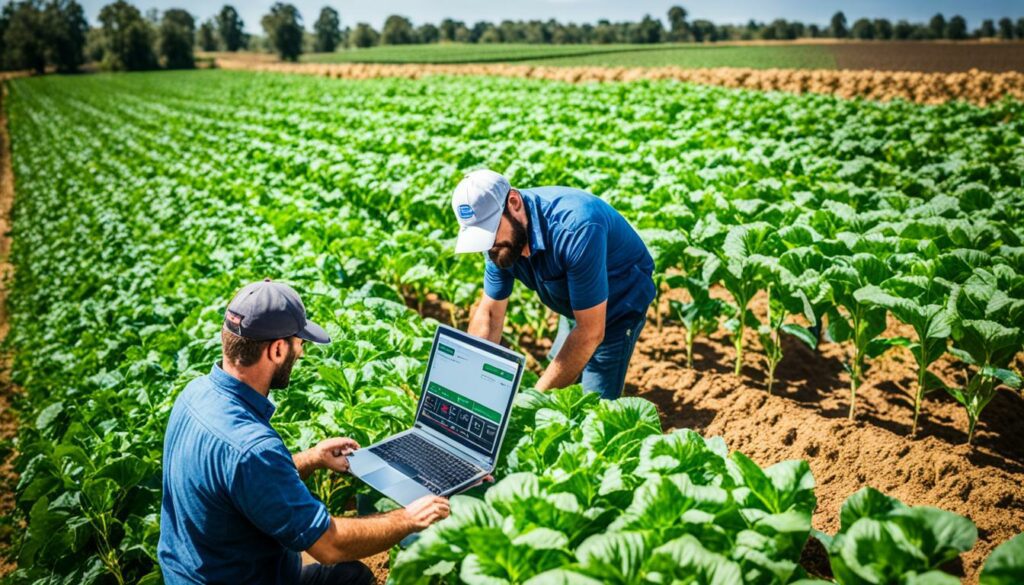
The Hitachi and Ag Automation partnership is a strong case of how online links help the environment and save money. They improved water use in dry places like Idaho and eastern Oregon. This was done by automating the collection of moisture data in the soil. They also allowed farmers to control irrigation systems from afar. This cut down on costs and energy.
Smart farming platforms bring together various tech tools to make farming better. Hitachi’s solution mixes moisture sensors, weather stations, and other tools. This system makes collecting data and planning easier. It lessens the work needed, boosts harvests, saves energy, and cuts down on carbon. That strengthens the food supply and farming in general.
| Benefits | Details |
|---|---|
| Improved Water Management | Automation collects soil moisture data and enables remote monitoring, reducing water usage. |
| Energy and Cost Efficiency | Less energy and fewer costs, with fewer miles on farm vehicles. |
| Enhanced Crop Quality | Better monitoring means crops are more even and of higher quality. |
| Sustainable Agriculture | Cuts down on carbon and saves energy, making farming more sustainable. |
Thanks to tech collabs and digital solutions, farmers can tackle modern challenges better. These partnerships and tools are creating a sustainable farming environment. They offer ways for smarter resource use and for better farming outcomes.
Digital platforms are changing the market game in agriculture. They make supply chains smoother and cut the cost of doing business. Using an online agricultural network means sharing information fast, changing how deals are done.
Now, digital platforms agricultural collaboration improves how supply chains work. Thanks to IoT, sensors, and blockchain, everyone can see the process clearly. Better tracking means less waste and more goods at the right time. This is a big part of what the USDA and European Commission aim for with their projects.
Digital setups bring down costs by taking out the middleman. With an online agricultural network, farmers and buyers connect directly. This direct link, like through CropIn and AgriApp systems, lowers waste and boosts the supply. Plus, smart technology like AI makes managing deliveries cheaper, making the whole system more efficient.
| Benefits of Digital Platforms | Technological Solutions |
|---|---|
| Improved Resource Utilisation | IoT, sensors, drones |
| Enhanced Food Safety | Blockchain, cloud computing |
| Boosted Food Production | AI, DSS, robotics |
Digital platforms for agricultural collaboration are changing farming deeply. They bring technology into every farming step. These technologies, like the Internet of Things and drones, make farming more precise and efficient.
Digital agriculture helps us keep up with our growing needs without harming the earth. It uses smart tech to produce food in a better way. This approach also helps in using less resources, making food safer, and fighting climate change. But, it’s key that we manage the data well for these tech steps to work for everyone.
Important policies like those from the USDA and European Commission support these tech changes. They aim to make farming both high-tech and eco-friendly. Our study shows how these new systems can fit into broader goals for the planet and society.
Using digital tools in farming can help solve big problems like climate worries and soil damage. The new location tech and handheld devices are a big help. They give farmers important info for better farming methods.
These digital platforms mark a big shift towards more earth-friendly and effective farming. They show us the future of farming is about using tech wisely. This mix of farming and tech could lead to big changes, with creativity, teamwork, and a strong focus on the planet’s future.
Digital platforms create online spaces for farmers to connect and trade. They bring farmers, buyers, and sellers together, boosting work and income. They’re especially helpful for small farmers by offering vital services.
They break down old barriers for small farmers. Now, farmers can reach buyers, learn new skills, and grow their business online. This supports smart farming and fair practices.
The important groups are banks, big farms, phone companies, and the government. They run the platforms that help farmers with cash, markets, and agricultural laws.
Mercy Corps AgriFin’s DAP Program is a great example. It worked in Kenya and Nigeria, showing how digital farming tools can work. It also looked at how well they do their job.
They make it easier for farmers to find buyers and sellers. This means farmers can sell more, make more money, and improve their lives.
They find it tough to get new customers and to work with others in the field. Not having enough money is also hard. Overcoming these problems is key to making digital help effective.
They help farmers use new tech and money tools for eco-friendly farming. This makes farming better for the planet and helps farmers survive tough weather.
They make sure women can also farm better by giving them access to money and info. This helps women do well in farming, too.
They help farmers learn from each other and from experts online. This info is vital for farmers to make smart choices.
More high-tech tools and smarter machines will change farming. This will make farming more exact and better, producing more food.
Some places are using digital tools a lot and it’s changing farming for the better. Farmers in these places are growing more food, selling better, and making more money.
They give money for new ideas, help teach farmers how to use them, and check if they work. Their help is important to make digital farming tools work well.
Online platforms and smart tech help farmers make important connections. These are vital for a farm’s success and to keep farming going.
They make selling and buying easier and cheaper for everyone. By linking farmers and buyers directly, they speed up farming markets.